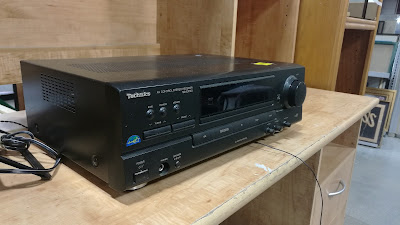Component Review: Nakamichi BX-100 Cassette Deck
 |
| BX-100E and 125E promo flyer |
One such deck is the BX-100. Introduced in 1984 it was the descendant of BX-1; Nakamichi's first true offering in the "entry" level market ($349 isn't exactly entry level but it was pretty cheap for a Nak) . Their goal with the BX-100 was the same as it was the BX-1 in 82, take the technology and designs they developed for there high end offerings and offer them at a more moderate price point while still delivering a class leading product. Like it's predecessor the BX-100 fully embodies this concept. This dual head deck offered performance that even some of the more expensive three head decks couldn't match. It's interesting computer controlled cam driven transport also delivers the obligatory "silent transport" that Nakamichi demanded in all their decks regardless of price.
As mentioned above the BX-100's biggest feature was it's "silent transport". Despite being a single capstan deck it used 2 dedicated computer controlled motors for tape take up and capstan duty to ensure a smooth constant speed. The capstan also uses a novel cam drive design with it's own computer controlled motor for more precise control which only runs when needed to avoid unwanted vibrations. It also uses a metal pulley on the belt driven take up reel instead of in Nakamichi's words " A plastic wheel of questionable concentricity". While all of this resulted in an impressively silent transport in a pretty low cost deck given it's provenance it has also lead to issues as these decks have aged, the motor controlling the cam likes to fail and due to the compact nature of the transport is a bit of a pain to deal with though replacements are plentiful (even today); also in some cases the IC controlling the motor can freak out (replacing it means finding a donor unit). Most of the effected units seem to be from 84 to 85; units from 86 and up as well as the later E models seem to use a more reliable motor and possibly have a revised IC controlling the transport logic and don't really seem to experience the same issues at least to the same extent as the earlier models.
As far as playback goes the BX-100 is a real treat, even my cheapest prerecorded tapes can sound pretty amazing on this deck. I've tricked quite a few people that they were listening to a CD with my cassette copy of Micheal Jackson's Bad on this deck. If you are fortunate enough to have prerecorded chrome tapes then prepare for a real delight. The little Nak continues to impress on the recording front as well with support for chrome and metal tapes, Dolby B noise reduction as well as independent input levels for left and right. It also has a one touch automatic fader that lets you fade the audio in our out with one simple touch, kind of a gimmick but still kinda neat. Like most Nak decks aside from the RX line it is a single side play and require you to flip the tape but that is to ensure that the tape head is always in alignment, which may be a bother to some but Nakamichi has always put function over convenience when designing a product. As for over all performance the only deck I have personally that can truly embarrass it is my Sony TC-K777 from 1981, though to be fair it retailed for $950 so it better damn well beat it. Now that isn't to say that it is the end all be all of tape decks but given it's relatively humble stature it's pretty impressive how many more expensive decks this budget Nak can trounce.
The BX-100 was available in the iconic Nakamichi black anodized finish with yellow lettering as well as a rarer silver face with black lettering, the silver is pretty uncommon but can be found if you must have silver. All the controls (aside from the tape type selectors) are soft touch computerized switches couple that with the red led vue meters and you have a thoroughly classy mid 80's look. As for inputs and outputs you get standard RCA in and out, nothing fancy like variable gain outs but again this is a "budget deck".
Summary: Overall this is a very solid "budget" deck and given that they don't usually go for more than $75 with shipping online and a working unit can be found pretty regularly for under $50 in the wild it's a no brainer. You can spend twice as much and still not beat this little gem in both looks and performance. If you find one and you are in need of a solid deck for playback or even recording tapes then do not hesitate to pick it up.
Typical cost (at time of writing):
In the wild: $15-45* (depends on store and region)
Online: $60-$100 (includes shipping)
*(depends on store and region prices are based on what I have personally seen or have paid )
Pros:
- Dual Head
- "Silent" Transport
- Tape Type Selector (Type I, II, IV)
- Dolby B NR
- Independent input volume controls
- Healthy selection of controls
- Cam drive motor is pron to issues
- Cam logic IC does go flaky in some instances



Comments
Post a Comment